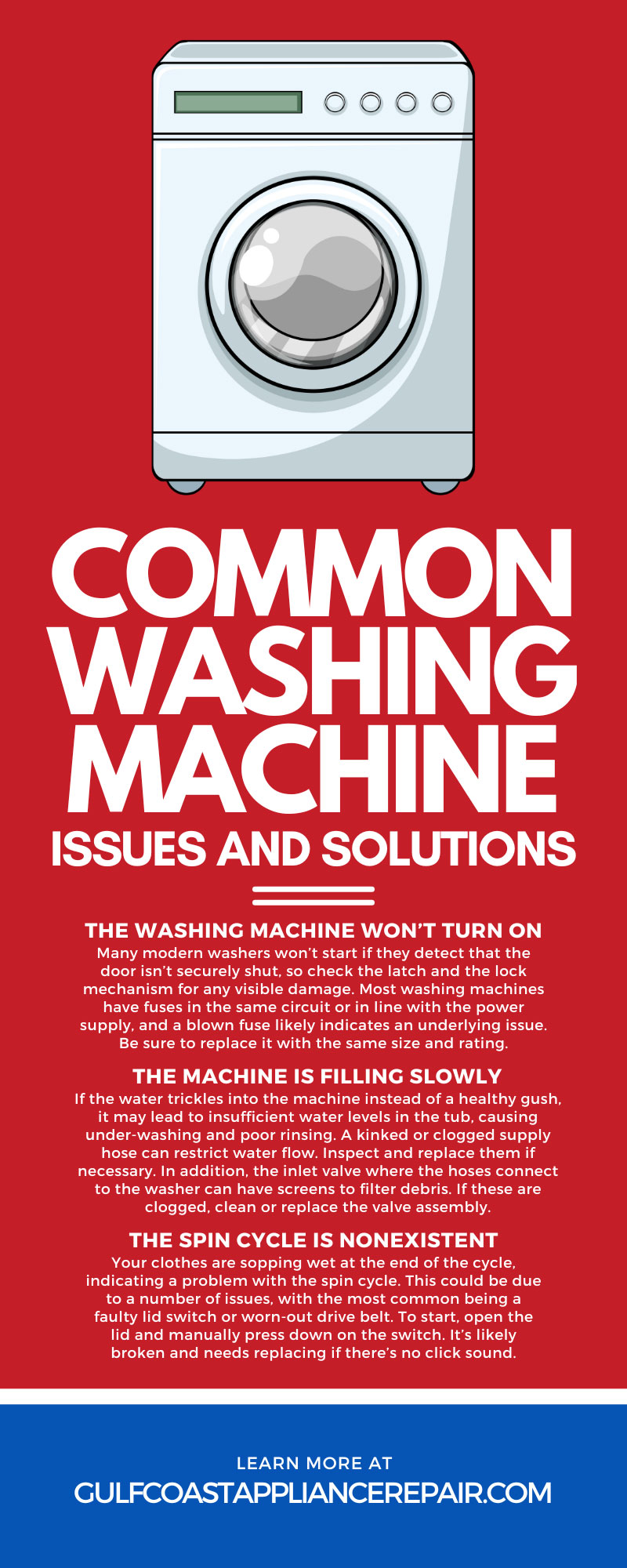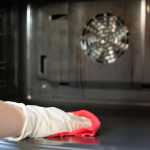Your washing machine is a workhorse of modern household technology, diligently cleaning load after load of laundry.
With all that hard work, it’s no wonder they can sometimes encounter issues. If you’ve ever found yourself staring at a soapy puddle on the laundry room floor or scratching your head at a particularly loud spin cycle, you’re not alone. In this comprehensive guide, we walk you through some of the most common washing machine issues and practical DIY solutions to help you avoid the hassle and cost of professional repairs.
1. The Washing Machine Won’t Turn On
You wake up to a pile of dirty laundry but find your washing machine unresponsive. The most common reasons for this issue are a faulty control board, timer, or fuse. Start by checking the power supply. Sometimes, the solution is as simple as ensuring you have the machine properly plugged in and that the outlet is functioning. Use a multimeter to test it.
Many modern washers won’t start if they detect that the door isn’t securely shut, so check the latch and the lock mechanism for any visible damage. Most washing machines have fuses in the same circuit or in line with the power supply, and a blown fuse likely indicates an underlying issue. Be sure to replace it with the same size and rating. Unfortunately, if you have timer and control board issues, they might require the expertise of a repair technician.
2. The Machine Is Filling Slowly
If the water trickles into the machine instead of a healthy gush, it may lead to insufficient water levels in the tub, causing under-washing and poor rinsing. A kinked or clogged supply hose can restrict water flow. Inspect and replace them if necessary. In addition, the inlet valve where the hoses connect to the washer can have screens to filter debris. If these are clogged, clean or replace the valve assembly.
Sometimes, a malfunctioning pressure switch can be at fault. This component usually regulates water levels in the washer, so if it’s not filling, this could be the issue.
3. The Spin Cycle Is Nonexistent
Your clothes are sopping wet at the end of the cycle, indicating a problem with the spin cycle. This could be due to a number of issues, with the most common being a faulty lid switch or worn-out drive belt. To start, open the lid and manually press down on the switch. It’s likely broken and needs replacing if there’s no click sound.
The drive belt is a rubber band that wraps around the motor and transmission. Regular wear and tear may have frayed, cracked, or outright broken it, so replace it if you notice damage. If neither of these is the cause, it may be time to call a professional to diagnose potential motor or transmission issues.
4. There’s Water on the Floor After a Cycle
A mystery puddle around your washing machine can be a sign of a water leak during the wash cycle or when not in use. This calls for an investigation to identify the source. The most common cause is a leaking or burst supply hose. Inspect them for cracks and replace the hose if needed.
The drain pump can leak if there’s damage to the seals or pump body. You should also check its hoses and connections for any visible issues. The rubber door gasket is another component that can wear out over time. Wipe it dry and inspect for any tears or holes.
5. Unusual Sounds During Operation
Washing machines can make various sounds during operation, but overly loud or unusual noises may indicate underlying issues, such as worn-out bearings, a damaged motor coupling, or an imbalanced load. An unbalanced load can cause banging. If you hear it, stop the cycle, rearrange the load, and try again.
You may also hear a high-pitched noise, which can indicate a worn-out pump or pressure switch. Worn-out bearings or a failing drive pulley can cause a grinding noise. You will need to replace these components if you notice damage.
6. The Washer Doesn’t Agitate
When your washer fills up and drains without moving the laundry, the agitation mechanism is clearly not working. This is often due to a compromised motor coupling, transmission, or a worn belt. To remedy this, access the motor and transmission to check if the coupling has broken. This part connects the motor to the transmission and is easy to replace.
If the motor coupling is fine, the issue may be with the transmission or clutch. Transmission or clutch problems may require the help of a professional washing machine and dryer repair service.
7. The Machine Smells Moldy
A foul smell coming from your washing machine can be a real dampener on laundry day and most likely indicates a buildup of mold and mildew. Run a hot water cycle with white vinegar or a specialized washing machine cleaner. To ensure the problem doesn’t happen in the future, regularly inspect and clean the door gasket, dispensers, and other areas where water can pool. After use, leave the door open to allow the interior to dry out and prevent mold growth.
8. The Laundry Still Smells After a Wash
If your clothes don’t smell fresh even after a cycle, it may be time to look into deep cleaning your washer. Also, always use the right water temperature. Remember, hot water is best for sanitization.
Avoid overloading the machine, as it can reduce the efficiency of the detergent. Over time, grime and detergent buildup can be a haven for bacteria. Regular cleaning can improve the situation.
9. The Control Panel Is Malfunctioning
An erratic control panel can lead to seemingly nonsensical behavior from your washing machine, such as starting and stopping at random or not responding to your commands. A power surge or electronic malfunction might have damaged the control board. If this is the case, replacement is the sure way ahead.
Loose or damaged wires could also be the cause. You’ll need to carefully inspect and reconnect or replace as needed. If the issue is with the display and not the control board, you may need to replace it.
10. Lint or Residue on Clothing
Finding lint balls on your clothes post-wash might be a concern, as it hints at issues with the machine’s ability to rinse. Use the correct amount of detergent—too little may not clean, while too much can leave residue.
You may also need to inspect and clean out the filter if it’s clogged. It’s usually at the bottom front of the washer.
Keep Your Washing Machine in Prime Condition
By familiarizing yourself with these common washing machine issues and their solutions, you can become more self-reliant when tackling washing machine woes. However, always exercise caution and recognize your skill level and comfort with DIY tasks before undertaking any repairs. For situations requiring in-depth knowledge or more technical expertise, don’t hesitate to contact a professional. Remember, a well-maintained washing machine makes for cleaner clothes and adds to the efficiency and longevity of a crucial household appliance.






